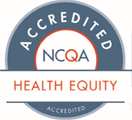Another group or vendor provides the info on the next page. If you don’t want to leave our site, choose the “X” in the upper right corner to close this message. Or choose “Go on to next website” to move forward.
Health equity and justice for all
.jpg)
Health equity and justice for all
To achieve good health outcomes, it’s key to understand how all these things connect:
- Social determinants of health (SDOH)
- Cultural competence
- Adverse childhood experiences (ACEs)
- Institutionalized racism
- Health disparities
- Reduce racial/ethnic inequities in the quality of health care people receive
- Improve access to timely health care and preventive health services
- Overcome health system barriers that can limit ability to get the desired care or benefits from services
- Remove interpersonal and institutional biases that may prevent some people from getting effective care and services
- Increase workforce diversity in our organization and provider networks
Policies and practices:
- Ensure equitable access and nondiscriminatory practices
- Identify and understand the needs of individuals and families
- Work with natural, informal support and networks within culturally diverse communities
- Align with national and state standards
Strategic direction includes:
- Assessing population health to determine community needs
- Addressing targeted need to help determine interventions
- Using best practice solutions for use based on proven interventions for the target population
- Evaluating and measuring practice effectiveness
- Providing affordable, quality care that addresses SDOH and is affordable
Training emphasizes:
- Personal and organizational values that impact health care delivery
- Communication and empathy to create connections
- Knowledge and skill integration to improve health outcomes and prevent institutionalized racism and discrimination
How members internalize health equity:
- Self-reflection
- Values
- Awareness
- Knowledge
- Integration
How providers and organizations apply health equity:
- Federal guidelines, like the national standards for culturally and linguistically appropriate services (CLAS) in health and health care
- Sales proposals and contracts
- Policies and procedures
- Workforce
- Environment
Commitment to health equity
We’re committed to addressing health equity and providing culturally responsive care to our members as part of our community engagement work. We’ve made organizational investments in staff and provider training. And our contracting and community investments reflect our focus on SDOH.
The equity journey begins with knowing ourselves, our communities and the members we serve. Our goal is to connect, listen, learn and improve conditions. To meet this goal, we:
- Assess the population
- Analyze the information
- Ensure that data guides interventions and decision-making at all levels
We want to reduce health disparities and ensure health care equity and justice for every member, regardless of race, ethnicity, gender or socio-economic status. So we remain committed to continuously:
- Increasing cultural sensitivity
- Advancing health literacy
- Implementing best practice programs
Our multimodal approach addresses health equity root causes through:
- Added services
- Traditional care management (CM)
- Disease management programs
- Focused community-based programs
Our programs have helped members overcome disparities, leading to improvements in behavioral health and pregnancy outcomes, as well as management of chronic conditions like diabetes and hypertension.
Everyone needs health information that guides decisions about their personalized health care needs. Services, care and information should be easy to understand to improve health, longevity and quality of life. Member health education and health literacy are essential to achieving these goals.
To promote and increase health literacy, we continuously work to understand the needs of members and potential members. We meet them where they are emotionally, culturally and physically (in their communities).
Our model for health promotion and health education focuses on:
- Understanding the unique needs of the population
- Becoming familiar with best practice interventions for the population
- Offering multiple methods to deliver these messages and identified activities
By focusing on health literacy and health equity issues, we’ve improved accessibility to health care for our members. We use healthy equity as a lens and develop our health education efforts using these best practice guidelines:
- Speaks to me: We put ourselves in the shoes of the intended audience and get to know the population and bring their ideas to communication efforts.
- Readability: We avoid big words, focus on big ideas and consider the communication method and delivery of the message.
- Picture this: We ask if the targeted population can see themselves in the images we use, complete a diversity check and align photos with the intended audience.
- What next: We include a call to action that offers simple to more difficult interventional options, understanding that people vary in their readiness to engage in health interventions.
- Who benefits: We seek to include messages from relatable peers and early adopters to help convey messages that are engaging, beneficial and effective.
Monitoring efforts
Our efforts include input from our Member Advisory Board in coordination with the Health Equity Representative from each state. All representatives are members of the National Health Equity and Engagement Team (HEET).
Member-focused engagement

Member-focused engagement
Successful member engagement relies on:
- Working closely with members
- Offering feedback and support to members
- Keeping members motivated to make positive health improvements
All this requires multiple touchpoints that extend beyond just face-to-face appointments.
Through engagement platforms and mobile health applications, our staff and providers continue to communicate with members virtually between appointments to provide comprehensive and holistic care.
Successful engagement also means being ready to address members’ whole-person needs, such as:
- Nutritious food
- Employment
- Housing
- Education
- Transportation
- Interpersonal safety
These needs are often called social determinants of health. Our goal is to provide a personalized care experience for members in their communities. We can do this by leveraging CVS Health® and Aetna® assets and partnerships with trusted community-based organizations. Our investment in digital platforms allows us to better identify, connect and monitor member needs and link them with community resources.
Our consumer and member education services include tools to improve understanding of benefits and services. These services result in improved health outcomes and independence.
We provide materials and support in formats best suited to populations and members we serve in person, telephonically and/or virtually. To improve the quality of health care services for our members, we align all our practices with the:
- National Culturally and Linguistically Appropriate Standards (NCLAS)
- National Committee for Quality Assurance (NCQA)
- Americans with Disabilities Act (ADA) regulations
Improving health starts by ensuring a person has basic information about the health care services available, what they mean and how to access them. The best approach is to ask during our first contact and offer a variety of options to get them the information they need. We do this through a combination of in-person, telephonic and virtual methods, including:
- Listening sessions and focus groups
- Street fair events
- Social media
- New member welcome calls
- Videos on YouTube
- Virtual applications
- Telehealth
Members have access to all written materials in the threshold languages of the communities we serve. They also have access to interpreters for all verbal communications.
We meet the needs of our Spanish-speaking members through our Spanish member website, which:
- Offers tools and services in Spanish, English or both to help members make informed decisions and keep themselves and their families physically and financially healthy
- Includes a glossary of common medical and health insurance terms written in everyday language to help ensure members understand disease management programs, as well as plan materials and descriptions
- Offers questions members can ask their health care providers to help make health care visits better and more productive
- Employs Spanish-speaking member representatives who can speak directly with members who prefer Spanish-speaking support
Members with disabilities have access to auxiliary aids and alternate methods of communication. To meet the needs of those who are deaf or hard of hearing, we train staff to:
- Use text telephone (TTY)/telecommunication device for the deaf (TDD)
- Ensure that members understand communication about new member enrollment or care management (CM) programs
- Recognize when a member needs extra support to engage more fully in their health care
Our platforms support closed-loop referrals for services such as food and housing. They can filter and identify organizations by “populations specialized in serving deaf or hard of hearing.” This allows us to find trusted community organizations to help meet member needs.
We comply with the Web Content Accessibility Guidelines (WCAG) 2.0, which defines how to make web content more accessible to people with disabilities.
To meet the needs of those who are blind or visually impaired, we train staff to understand member rights. For example, we ensure members receive materials like the member handbook or treatment plans in large font size or braille if they request it.
Since materials alone can’t guarantee that members are able to fully engage with their care, it’s vital that our staff and network providers can recognize the need for extra support. They also need to find the appropriate resources that are accessible to members in the community.
Provider-focused engagement
Provider-focused engagement
The provider-patient relationship is a key component of achieving superior health care and satisfaction for our members. To effectively address issues of health equity, we must help develop a workforce that reflects the people it serves. Our provider engagement efforts include:
- Ensuring that our providers have the skills, knowledge and information to best serve our diverse members
- Expanding the workforce to include more providers who reflect the members we serve

- Recruit, promote and support a culturally and linguistically diverse provider network responsive to the population in the service area
- Educate and train providers in health equity, which includes an understanding of unconscious bias, ACEs, SDOH, health disparities, institutionalized racism and culturally and linguistically appropriate practices.
- Ensure that providers inform all members of the availability of language assistance services clearly and in their preferred language, verbally and in writing
- Collect and publish information on the languages contracted providers speak fluently, or languages for which translation services are offered
- Collect and disclose provider race and ethnicity data
- Analyze the provider network’s ability to serve members’ health needs and develop ways to address gaps
Our PAC and CAAC meet quarterly to:
- Share perspectives on how we can better serve our members
- Provide expert council to improve access, provider satisfaction and connection to specialty providers
- Review satisfaction survey results
- Provide actionable feedback on policies and programs to improve care for our members
We also help providers understand and act on member data to improve care. We also work with providers to track and analyze their feedback regionally. This helps us assess and identify areas of improvement, such as provider education and training.
Provider training

Provider training
Training topics range from medical record review to linguistic and cultural competency. We facilitate provider engagement and education with:
- Ongoing communications
- Provider meetings
- Webinar trainings
All plan employees and network providers take part in this training. It focuses on the need to:
- Know the population and learn best practice strategies to address all populations
- Understand bias, cultural match and presence in provider selection
- Prevent discrimination and racism
This training discusses federal, state and contract requirements and processes to meet or exceed the National Standards for Culturally and Linguistically Appropriate Services (CLAS) in Health and Health Care. We seek recognition as a National Committee for Quality Assurance Multicultural Distinction in Health Care organization. This is a designation affirming adherence to meeting CLAS standards.
This training:
- Provides foundational trauma-informed care training upon onboarding for all staff and providers
- Offers access to technology-based trainings on our health plan website and Provider Portal
Sources
- Braveman P, Arkin E, Orleans T, et al. Robert Wood Johnson Foundation. What is health equity?
May 1, 2017. Accessed June 6, 2022. - Centers for Disease Control and Prevention (CDC). Health equity. March 3, 2022. Accessed June 6, 2022.

